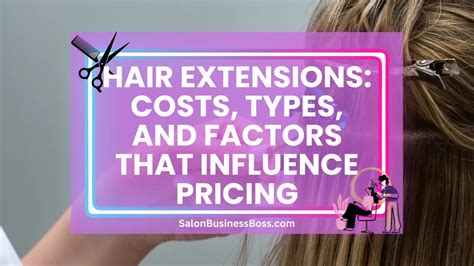Indulging in luscious, voluminous hair extensions can elevate your style and transform your appearance. However, before taking the plunge, it’s essential to understand the cost implications associated with this beauty treatment. This article delves into the various factors that influence hair extensions cost, empowering you to make an informed decision.

Types of Hair Extensions: A Cost Comparison
The type of hair extension you choose significantly impacts its price. Here are the main categories:
- Human Hair Extensions:
- Remy Hair: $200-$600 per bundle
-
Non-Remy Hair: $100-$300 per bundle
-
Synthetic Hair Extensions:
- Kanekalon: $20-$50 per pack
-
Heat-Resistant: $50-$150 per pack
-
Mixed Hair Extensions:
- Human and Synthetic Blend: $120-$300 per bundle
Application Methods: From Weaves to Bonds
The technique used to apply your hair extensions also affects the cost:
- Weaving: $150-$300
- Tape-In: $300-$600
- Keratin Bonding: $500-$1000
- Micro-Beads: $400-$800
Salon Location and Experience: A Geographic Divide
The location and reputation of your chosen salon can also influence the price:
- Urban Salons: Expect higher costs due to higher overheads and competition.
- Suburban Salons: Offer more affordable options due to lower operating costs.
- Experienced Stylists: Charge a premium for their expertise and client base.
- Apprentice Stylists: Offer discounted rates while gaining hands-on experience.
Maintenance and Upkeep: A Continuing Investment
Remember that hair extensions require ongoing care to maintain their appearance and longevity:
- Regular Trims: $30-$50
- Conditioning Treatments: $20-$50
- Removals and Re-Applications: $100-$300 (depending on the method)
Other Factors That Influence Cost
Beyond the primary factors, several other considerations can also impact the overall cost:
- Length and Volume: Longer and thicker extensions are more expensive.
- Color and Texture: Custom colors and unique textures come with a price premium.
- Brand and Quality: Reputable brands offering high-quality hair will cost more.
- Promotions and Discounts: Keep an eye out for salon specials and discounts to save money.
A Step-by-Step Guide to Budgeting for Hair Extensions
- Research and Consult: Consult with multiple salons to compare prices and techniques.
- Determine Your Needs: Consider the desired length, volume, and type of extension that suits your hair and lifestyle.
- Set a Budget: Allocate a realistic amount for the initial application, maintenance, and potential re-applications.
- Explore Financing Options: Some salons offer payment plans or financing options to make the cost more manageable.
- Consider DIY: If you’re skilled and have the time, applying hair extensions yourself can significantly reduce costs.
Frequently Asked Questions (FAQs)
- How long do hair extensions last? Remy human hair extensions typically last 6-12 months with proper care.
- Can I dye or style hair extensions? Yes, but it’s recommended to consult with a professional hairstylist for guidance.
- Will hair extensions damage my natural hair? When applied properly and maintained, hair extensions should not damage your hair.
- What is the best type of hair extension for fine hair? Tape-in or micro-beads extensions are generally recommended for fine hair as they are less damaging.
- Can I swim or exercise with hair extensions? Yes, but it’s important to avoid chlorine and excessive heat to prevent damage.
- How often should I get my hair extensions removed? Every 6-8 weeks to prevent matting and maintain a healthy scalp.
Conclusion
Understanding the various factors that influence hair extensions cost is crucial for making an informed decision. By considering the type of hair, application method, salon location, maintenance, and other factors, you can create a budget that aligns with your needs and desires. Remember to prioritize quality and consult with a reputable salon to ensure a satisfactory outcome. Invest wisely in your hair extensions and enjoy the confidence and beauty they bring.
